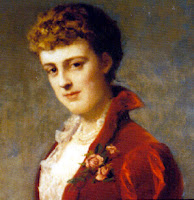As we turn the page on another year and even an entire era in American life, it’s useful to look back and see how others from earlier times marked turning points. Few such writers were more acute in their observation than Edith Wharton, one of my favorite authors. (And right here is a plug for The Mount, her Berkshire mansion, which, like her most famous heroine, Lily Bart of The House of Mirth, found itself in considerable financial distress this past year—and which could use all the visitors and financial support it can get.)
As I was researching this post, I was thrilled to find that there’s a delightful blog about the author—and that its December 27, 2008 post highlights a New York Times article about her birthplace at West 23rd St., a five-story structure that was converted to commercial use some time ago and is now a Starbucks.
When she wrote The House of Mirth in 1905, Wharton was scathing in depicting the constrictive upper-crust society from which she sprang. With the distance provided by a cataclysmic world war and a move across the Atlantic to France, however, her attitude had evolved into something more complex. Sure, she could still decry, in The Age of Innocence (1920), “the old New York way of taking life 'without effusion of blood’,” but, like protagonist Newland Archer, she felt out of place in the rough-and-tumble world that replaced it.
Wharton’s original proposed title for this Pulitzer Prize-winning novel—the first ever won by a woman, incidentally—was Old New York, but her publisher rejected it. But once she had the bit between her teeth, she was not ready to let go so easily. So she used it for her 1924 quartet of novellas spanning from the 1840s to 1870s.
“New Year’s Day,” the last novella in the group, has not won the critical acclaim of two others, “False Dawn” and “The Old Maid” (the latter was made into an unjustly neglected 1939 Bette Davis-Miriam Hopkins film). Still, the Wharton style—elegant, yet clear as a country brook—is here, along with a lightly amused attitude toward social dinosaurs such as Sillerton Jackson.
In reflecting on Old New York, the closest counterpart to it that I could come up with was, believe it or not, John O’Hara’s Sermons and Soda-Water (1960), another novella collection set in what seemed to the author like an increasingly distant past.
True, there’s the kind of difference you’d expect between a woman to the manor born, coming from a world in which Catholics and Jews were pointedly excluded, and a lapsed Irish-Catholic who desperately aspired to the society of the wealthy but felt excluded by his ethnicity from ever really belonging to it.
But both Wharton and O’Hara wrote their books in the later part of midlife, when they could see the end coming not just for themselves but for their world, and their worldviews had evolved into something that veered between nostalgia and conservatism. That left them all the more resolved to record not just the details of that world—say, how little kids chased after fire engines, for Wharton, or the Gershwin tunes one might hear at a country club, for O’Hara—but the social mores of this American aristocracy. "I have work to do, and I am afraid not to do it," O’Hara wrote a few years later in the foreword to a collection of short stories, The Horse Knows the Way.
Both authors were also obsessed with affairs of the heart and with how marriages endure—or fracture. The best novella in Sermons and Soda-Water, “Imagine Kissing Pete,” is about a bad marriage that, against all odds, survives and even, to an extent, thrives. “New Year’s Day” concerns an adulterous liaison that the narrator, as a boy, discovers in a hotel across the street from his 23rd Street brownstone; about the adult disapproval that clues him into the fact that a major transgression, a defiance of the social order, has taken place; and about how the beautiful woman at the center of the scandal lives out the rest of her life.
The Fifth Avenue hotel where the affair occurs is scorned by New York aristocrats, chiefly because of the unrefined, overdressed partygoers who congregate there for the holiday. Little do they know that it’s this hoi polloi, not themselves, who represent the wave of the future in Gotham.

No comments:
Post a Comment